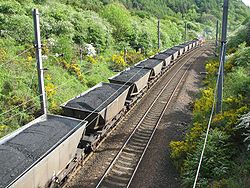- Merry-go-round train
-
 A merry-go-round train hauled by a Class 66 locomotive
A merry-go-round train hauled by a Class 66 locomotive
A Merry-go-round train, often abbreviated to MGR, is a block train of hopper wagons which both loads and unloads its cargo while moving. In the United Kingdom, they are most commonly coal trains delivering to power stations. These trains were introduced in the 1960s, and were one of the few innovations of the Beeching axe, along with investment from the CEGB (Central Electricity Generating Board) and the N.C.B (National Coal Board) into new power stations and loading facilities. West Burton Power Station was used as a testing ground for the MGR system [1] but the first power station to receive its coal by MGR was Cockenzie in Scotland in 1966.[2] It was estimated at the time that the 80 MGR hoppers needed to feed Cockenzie would replace up to 1500 conventional wagons.[3] A 1.2GW power station, such as Cockenzie, receives up to 3 million tons of coal a year, whereas a larger 2GW plant, like West Burton, up to 5 million tons per year. Power stations that were built to handle the new MGR traffic were Aberthaw, Drax, Didcot, Eggborough, Fiddlers Ferry and Ratcliffe, all of which are still open for traffic at the present time. Many of the older power stations were gradually converted to MGR operation.
Contents
Balloon loop
Associated with merry-go-round trains are the construction of balloon loops at the origin and destination so that the train doesn't waste time shunting the engine from one end of the train to the other. However, whilst power stations such as Ratcliffe, West Burton and Cottam had balloon loops, few if any colliery/loading points had them and thus true merry-go-round operation never really existed.
Daleks
This is the nickname (from its appearance) given to the automatic door opening/closing equipment located on the approach to and from the bunker in the power station.
Wagons
When MGR services were first introduced, British Rail designed an all-new wagon with air brakes and a capacity for 33 tonnes of pulverised coal. The prototype was a 32 ton unit and was built at Darlington and tested in 1964.[4] Before the introduction of TOPS these wagons were referred to by the telegraphic code name "HOP AB 33", this was an abbreviation of Hopper Air Brake 33 tonne. With the introduction of TOPS in 1973 the wagons were given the code "HAA", over the years with modifications to wagons other codes have been allocated including HDA and HMA.
With the coming of privatisation to Britain's railways, new wagon types have been introduced by EWS (HTA), GBRf (HYA), Freightliner Heavy Haul (HHA and HXA) and Jarvis Fastline (IIA). These new wagons have increased tonnage and air-operated doors that do away with the need for the "Dalek" release mechanism at the power station end of the trip.
Locomotive control
Locomotives used on the MGR trains needed to be fitted with electronic speed control known as Slow Speed Control, so that the driver could engage the system and the train could proceed at a fixed very slow speed under the loading and unloading facilities. The system was originally fitted to some members of Class 20, Class 26 and Class 47. Later, some members of Class 37 were also fitted, while the system was fitted to all members of classes 56, 58, 59, 60 and 66. Additionally, all Class 50s were originally fitted, although the system was later removed due to non-use.
See also
References
Categories:- Rail transport
- Rail freight transport in the United Kingdom
- Rail transport stubs
Wikimedia Foundation. 2010.
